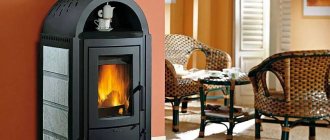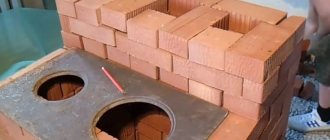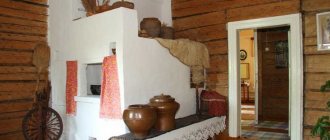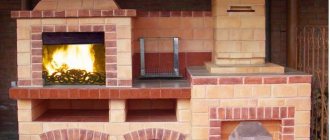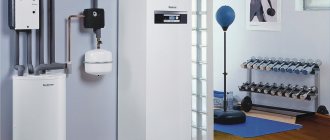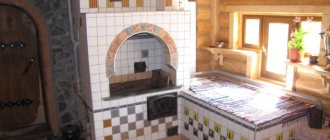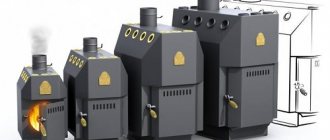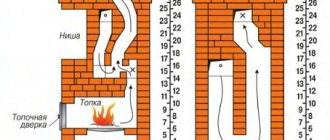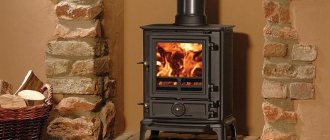A round stove with a massive metal casing was a common feature in films about the 1917 revolution. These are exactly the models of stoves that were installed in apartment buildings in Petrograd. Therefore, it is not surprising that all the scenes in the Bolshevik safe houses were filmed against the backdrop of such stoves. However, this stove design is still popular today, almost two hundred years after its appearance. But a round stove in a metal case differs from other types of stoves not only in its shape. This model, most often offered to consumers, combines the qualities of both a heating stove and a fireplace, which makes it very popular.
Device and elements
The operating principle of this heating system is based on a long, winding chimney, which makes it possible to heat several floors using a single structure.
The Dutch oven consists of a firebox and a long winding chimney. The design also includes a blower and several doors. In total, the Dutch style uses several elements:
- Blower and blower door;
- Firebox and fire door;
- Soot collection chamber and cleaning door;
- Chimney;
- Gate valve;
Each element performs its role and allows the circular structure to achieve maximum power levels by distributing a small amount of smoke throughout the heating system in an even amount.
The design of the Dutch oven also requires compliance with certain rules to maintain fire safety and ensure comfortable operation.
Design example
Design Features
Regardless of the modification, the Dutch oven consists of three main elements - a combustion chamber, a chimney and a mechanism for adjusting the speed of smoke movement. Other features worth highlighting are:
- lack of grate;
- the presence of six chimney channels;
- small size, as a result of which the stove fits perfectly into any interior;
- the shape of the structure can be different - from round to rectangular (only the firebox remains unchanged);
- thin walls (one brick thick) allow you to minimize the amount of fuel required for full heating;
- lack of a blower under the firebox;
- lack of a cast iron hob for cooking.
Attention! The only drawback of the Dutch oven can be considered the low intensity of fuel combustion, which is caused by the absence of a blower and grate. In this case, oxygen enters only through the firebox door in an amount insufficient for intense combustion
Fire safety rules
Before construction, study the PPB
Check out the diagram above, which shows in detail and accurately all the features of installing a Dutch oven in a standard-sized room. To ensure fire safety, an asbestos or metal sheet is needed between the stove and the floor, which will prevent unexpected fire in the room from sparks or fallen coals.
Expert opinion
Pavel Kruglov
Stove maker with 25 years of experience
If the system is installed in a wooden house, then a sheet is also needed between the wall and the stove to protect against fire. You should also know that there should be no furniture or flammable objects near the stove.
Dutch oven assembly principles, diagrams and drawings, step-by-step laying of the oven, ordering
Collapse
A Dutch brick stove is one of the most efficient solid fuel devices, used for heating by many people in our time.
This is a compact rectangular or oval-shaped device with high heat transfer, which is explained by the presence of fairly long smoke channels.
Flue gases generated during the combustion of wood or coal circulate through them, heating the thin walls of the furnace and preventing them from cooling for a long time.
| No. | Name of material and stove fittings | Unit change | Quantity |
| 1 | Ordinary ceramic brick M150 - M250 | Thousand PC. | 0,65 |
| 2 | Fireclay brick | Thousand PC. | 0,05 |
| 3 | Oily clay | kg | 90 |
| 4 | Coarse river sand | m³ | 0,5 |
| 5 | Grate 250x250 mm | PC. | 1 |
| 6 | Cleaning door 130x70 mm | PC. | 3 |
| 7 | Fire door 250x280 mm | PC. | 1 |
| 8 | Blower door 250x140 mm | PC. | 1 |
| 9 | Gate valve 130x130 mm | PC. | 1 |
| 10 | Gate valve 130x250 mm | PC. | 1 |
| 11 | Asbestos cord | m | 10 |
| 12 | Tempered steel wire | m | 10 |
| 13 | Steel strip 50x5 mm | m | 3,5 |
| 14 | Heat-resistant adhesive for strengthening masonry joints | kg | 20 |
To build a foundation you need to buy:
- Portland cement - 1 bag (50 kg);
- sand - 0.01 m³;
- crushed stone - 0.5 m³;
- reinforcing mesh with cell size - 0.84 m²;
- roofing felt - 0.84 m²;
- bitumen mastic - 8 kg;
- board for formwork assembly - 152 m³;
- nails - 0.2 kg;
- knitting wire - 15 - 20 m.
Painting
Painting is one of the most budget-friendly and simplest options. At the final stage of construction, the outer surface of the furnace is rubbed to reduce roughness and moistened with water, if desired, treated with a penetrating primer, and then with glue-based paint. Metal elements are painted with dark, heat-resistant paint.
Mazanka
Also refers to the simplest type of cladding. Muzanka is a manual finishing of the external walls of the structure and subsequent whitewashing. Furnaces treated in this way require cosmetic repairs every year, as cracks inevitably appear on them during operation.
Tiles
Using this method, the stove not only acquires an aesthetic, antique appearance, but also its heat capacity increases. Tiles are handmade ceramic tiles. They are practical and easy to maintain - to remove various dirt and dust, simply treating them with a damp sponge and detergents is enough. The tiles are painted by hand and come in various shapes and shades.
Finishing should be done using a mesh applied to the plaster, which will help facilitate the installation process and allow everything to be done more accurately and accurately. It is necessary to use special adhesive mixtures for tiles for lining stoves. They are characterized by increased resistance to high temperatures and retain slight ductility throughout their service life.
Materials and their quantity
| Name | Qty |
| Blower door | 1 piece each |
| Cleanout doors | 2 pieces |
| Fireclay brick | 50-100 pieces |
| Regular red brick | 200-500 pieces |
| Gate valves/gates | 2 pieces |
| Grate | 1 piece |
| Clay | 90 kilograms |
| Sand | Half a cube |
All doors can be purchased in specialized stores or at a building materials warehouse in your city. Many people order designer doors from local craftsmen so that their stove can become a design element of the room.
Expert opinion
Pavel Kruglov
Stove maker with 25 years of experience
If you decide to install a metal casing on the structure and at the same time make it yourself, then in addition to the above materials you will need several sheets of galvanized or roofing metal. Their number depends on the height of the stove and its width; usually 2-3 sheets are enough to make an iron case for a Dutch oven 3 meters high.
ORDER
Prices
Attention! The prices indicated in this section are only valid when ordering before August 10th of the year
Pensioners get a 10% discount on the price for work!
There are two options for cooperation.
1. You import the material yourself (a list of what you need will be given, recommendations, if necessary, too)
In this case, you only pay for work #8212; 39,000 rubles. This price is valid until August 10th of the year.
Payment after completion of work.
2. Turnkey. We bring everything we need and build the oven ourselves. 84,000 rubles. You pay 45,000 rubles on the day of delivery of the material, before unloading. The remaining 39,000 after completion of work.
As you can see, you are not risking anything. You don't pay anything up front.
1. Price #171;turnkey#187; may change if material prices rise sharply.
2. Price #171;turnkey#187; valid when an object (house, dacha) is located up to 50 km from St. Petersburg (from the ring road). If further #8212; let's agree.
3. Prices do not include the construction of the main chimney (pipe). If there is no pipe, you need to do it. The approximate price of a turnkey sandwich chimney (double-circuit stainless steel pipe) is about 35,000 rubles (if ordered together with a Dutch oven)
4. Prices do not include dismantling old furnaces and making a foundation.
5. Visiting the site for consultation is paid #8212; 1000 -2000 rubles (depending on where you go). When calculating upon completion of work, this money is counted towards payment.
Required Tools
For easy and quick installation, you need to prepare in advance a certain list of tools that will be useful to you in the construction of the Dutch oven:
- Pickaxe or guillotine;
- Measuring tools: level, tape measure, square;
- A basin for diluting the solution;
- Bucket and shovel for convenience;
- Mason's trowel.
If you make a metal casing yourself, then you will also need tools to assemble it: metal scissors, rivets and a riveting device, or a welding machine.
Brick heating stoves
Instead of a metal “jacket”, tiles are used for lining brick stoves. In this case, the thermal efficiency of the fireplace increases significantly. Tiles evenly distribute and retain heat, increase the safety of stove equipment and turn the stove into a luxurious home. Most often, in this case, the Dutch is taken as the basis for the design, giving it a rounded shape.
Luxurious cylindrical tiled stove
The easiest way to build an effective round hearth for heating a house or cottage is based on a ready-made cast-iron firebox. Instead of expensive and difficult-to-work tiles, affordable porcelain stoneware or soapstone - a practical stove stone - have recently been used for facing bricks.
Round stove based on a finished firebox, lined with soapstone
Stages of making a round Dutchman
Foundation
As with any other design, in order for a round Dutch oven to be stable and to function properly, you first need to make a foundation:
- To do this, you need to dig a recess into which the base for the stove will be installed.
- First, take measurements and disassemble the floor covering, deciding in advance on the future location of the system.
- Dig a hole and fill it with cement mortar of the following consistency: 1 bucket of cement, 3 buckets of sand.
- You need to place a reinforcement tie on top of the resulting future foundation so that the foundation better holds the Dutch structure.
- Let the solution dry for 10-15 days before starting work on the construction of the furnace.
Manufacturing of metal casing
Installing a metal casing on a Dutch oven was invented in the Russian Empire by the German designer Utenmark; such systems are often named after him - “Utenmarking”.
Today on the market of heating systems and products for them there is a wide range of ready-made metal casings for Dutch ovens. They are sold in ready-made sizes, so if you decide to use “utenmarking” purchased in a store, you should compare it with the dimensions of the oven in advance. The finished prefabricated metal casings look like this:
Metal casing
If you decided to make a metal casing with your own hands, then the material you can use is a regular galvanized sheet or roofing iron:
- It is better to prepare the blanks for installation in advance by first making holes for the firebox, valve, vent and door for cleaning. It is important to understand that the masonry is formed by the dimensions of the casing, so take this into account when making it.
Blanks for casing - A sheet of iron is fastened into a round shape using rivets; in extreme cases, the structure can be welded if the thickness of the metal allows this.
Laying and ordering
An important feature in the laying of a Dutch oven is the order of its rows; not every master is ready to undertake the installation of such structures, so the decision to make a round Dutch oven with your own hands is risky. But if you are confident in your skills, then it is important to use a specially invented order of this design.
Appearance
In cross-section, a round Dutch oven with a casing looks like this:
Sectional diagram of a round Dutch woman
Features of brick laying
The installation of the casing is carried out simultaneously with the installation of the Dutch. The section of the system, before covering the firebox, is placed in the floor of bricks - that is, the first three rows. Then, using a plumb line and level, the casing is installed - its first, lower ring. The distance between the wall of the case and the masonry is filled with a ready-made semi-liquid clay solution.
Now the firebox is being formed, and it is important to follow the order and bandaging so that the structure has good stability and high efficiency. When the firebox is formed, you can begin laying the subsequent parts of the Dutch system.
Front rows
Despite the apparent simplicity of the design, the main thing here is the order of the system; without it, the mason will not be able to install the entire system correctly. The first twelve rows begin like this, the diagram shows the dimensions and entire order of the Dutch woman:
Rows 1-12
From 13 to 29, the row and pipe diagram are shown in the following design order:
Rows 13-29
Rows 30-32
Please note that if one row is folded incorrectly, not to mention more errors, smoke will pour into the house and the system will not be able to function correctly.
First test firing of the furnace
It is important to carry out the first fire in accordance with certain rules:
- Test heating of the heating system must be carried out after the entire structure, including the masonry and facing mortar, has completely dried. Premature testing of the furnace can lead to cracking of the structure, which will deteriorate its technical characteristics and lead to operational problems.
- The first combustion is carried out using 1/5 of the fuel. First you need to lay down wood chips and shavings, and then you can add larger logs. In this case, all valves and dampers must be open.
Expert opinion
Pavel Kruglov
Stove maker with 25 years of experience
If you have a thermometer installed, then make sure that the temperature in the system does not reach 600 degrees Celsius - you need to carry out the test firebox carefully, constantly inspecting the entire structure for damage to the system.
Do-it-yourself stove laying
If you place the stove in the center of the house, it will warm up evenly.
Construction of the Swedes begins with preparation. It is necessary to calculate its power, find the optimal location - between rooms, as close to the center of the room as possible. It is better to build the furnace simultaneously with the construction of the building itself. It weighs about 3 tons and a separate foundation is laid for it.
It is possible to install a stove in a finished building, but to do this you will have to dismantle the floors, wall, and roof. It’s easier to purchase a metal analogue of the Swede - “Ryazanka” or another mobile cooking and heating model.
- A hole is dug under the foundation, up to 0.8–1 m deep. The value is determined by the level of soil freezing. The foundation must lie below this depth.
- The scheme is usual: up to 15 cm of compacted sand, 20 cm of broken brick and stone, 10 cm of crushed stone or pebbles and a layer of concrete of such a height that it rises 15 cm above the ground level. All layers must be compacted. The concrete is reinforced with reinforcing mesh: it is placed in the upper layers, 10 cm short of the open surface. The dimensions of the foundation are 10–15 cm larger than the dimensions of the furnace.
- After the concrete has dried, the foundation is waterproofed with roofing felt.
- It is recommended to insulate the bottom of the stove. The Swede is designed in such a way that it creates a powerful downward flow of heat. To avoid losing it, several layers of basalt cardboard are placed under the base of the furnace. A more expensive method is to lay out the lowest row of fireclay bricks.
- The Swedish oven is laid out with your own hands according to a certain pattern. You can find ready-made descriptions for a variety of sizes.
- Rows 1 and 2 are always solid. The brick is clay, laid with an offset and with strapping. This foundation ensures the strength of the structure.
- In the 3rd and 4th rows an ash pan and holes for cleaning are formed. They all close with doors. Their installation is the same: on twisted steel wire, which is fixed directly into the brickwork. From the 5th row, according to the drawing, they begin to form a firebox. It is laid with fireclay bricks, since clay bricks cannot withstand such temperatures. At the same time, install the oven. It is secured in the same way as doors - steel wire is walled up between the stones.
- In rows 6–9, the firebox continues to be built. At 6 a chimney duct is also laid. Fireclay bricks inside the firebox and clay bricks outside are laid so that there is an air gap between them. This prevents wall deformation. Attach the combustion door.
- In the 9th row, the bricks in the chimney channel are laid at an angle. They are given the desired shape with a grinder. This ensures that gases are vented into the chimney. At 10, the installation of the firebox is completed by installing a horizontal partition, and at 11, the hob is fixed.
- From rows 12 to 18, chimney channels are constructed according to the drawing. Their surface should be as smooth as possible. The walls are carefully leveled and the solution is smoothed. In the 17th and 18th rows, metal corners and supports are placed to cover the cooking chamber. An almost continuous row of bricks is laid here.
- From 19 to 28 they build an upper drying niche and lay holes for cleaning chimneys with views, and at 27 - a control valve.
- At level 29, the smoke channels are blocked, leaving only one main hole for the chimney. The drying chamber is also closed.
- In row 30 they make an expansion, and in row 31 they return to the original dimensions. Then a brick pipe is built up in a straight line. It is recommended to insulate the floor ceiling to avoid overheating. In the attic, you can connect a brick chimney with a metal one.
Conclusion
A Dutch oven with a metal casing will be an excellent heating system for two-story country houses, to which gas pipes cannot be connected and a classic boiler heating system cannot be installed. Also, round Dutch ovens are an excellent choice for any agricultural buildings - they do not have enormous power, but are able to heat the room for fairly comfortable living.
The design of round Dutch ovens with a metal casing is the main advantage of these heating systems - despite the complexity of installation, anyone can lay a stove if they use the required order and prepare the solution correctly.
Of course, if you are not sure that you can correctly lay the stove, then it is better to seek the help of specialist stove-makers who will be able to install the entire structure correctly, and the stove will function as it should.
Soot: brick or doors
In such a chimney, the issue of soot will definitely arise. The main disadvantage of such a chimney is the need for a large number of doors for cleaning (How to clean a chimney).
Doors greatly reduce the efficiency of the chimney. Uneven heating of brick walls and metal doors leads to large temperature differences inside the chimney and, as a result, to deterioration of draft.
The work does not require haste. The main thing when constructing this chimney is care and accuracy. Using the above tips and recommendations, you can successfully build a horizontal chimney for your stove.
>> ?
Having dealt with boilers, it’s time to talk about how to properly make a chimney
, having considered the different designs of chimneys and the requirements for their installation.
The chimney for the boiler is designed to remove fuel combustion products into the atmosphere. Actually, any heating boiler, if it is not electric, can only work if there is a properly made chimney.
What chimney designs exist?
The procedure for constructing the foundation
Foundation for the stove.
First, formwork is created from wooden planks. It should be 1 m in length and width and 20 cm in height. After creating and installing the formwork, a reinforcing layer is laid out. Reinforcement with a diameter of 8-10 mm should be laid in squares with a side of 20 cm. At the joints, the reinforcement should be connected using a special wire. Such a lattice cannot be laid directly on the ground, so you must first drive 4 pieces of metal rod into the ground and tie the reinforcing lattice to them by weight.
The next step is pouring the formwork. To do this, you can use a regular concrete mixture consisting of 1 part cement, 3 parts fine aggregate (sand) and 5 parts coarse aggregate (gravel, crushed stone). After pouring, the concrete should be given 2 weeks to dry. To speed up this process, you need to improve the ventilation in the room. To do this, just open the windows and doors. Place damp cloths on the floor and wet them periodically. This helps prevent cracks from forming in the concrete as it dries.

